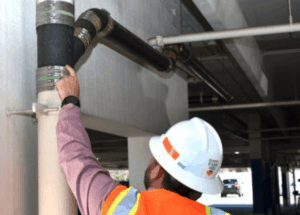We’ve Seen It All. We’ve Done It All.™
DWV Plumbing System Maintenance Best Practices
The Drain, Waste and Vent (DWV) piping system in a building is a crucial component of the overall plumbing infrastructure. The majority of DWV piping systems are hidden below floors, behind walls, and in ceilings. Out of sight, out of mind. That is until your previously fully functional plumbing system has a problem. Ongoing maintenance can identify small problems before they become costly in terms of building staff resources, product repairs, and the health and safety of occupants.
 Plumbing may be out of sight, but just like any other mechanical system, your DWV piping should be properly and regularly maintained, regardless of the material. In this issue we outline three steps to support DWV maintenance:
Plumbing may be out of sight, but just like any other mechanical system, your DWV piping should be properly and regularly maintained, regardless of the material. In this issue we outline three steps to support DWV maintenance:
- Develop a maintenance plan and budget
- Conduct an evaluation
- Perform maintenance based on evaluation results
Maintenance Plan & Budget
A DWV maintenance plan will keep your plumbing system top of mind. A maintenance plan will help facility management budget effectively and diminish the likelihood of a plumbing emergency that could send your building occupants reeling.
Identify the tasks that need to be done based on the needs of your building. Include frequency of evaluation, such as monthly, quarterly, semi-annually, and annually. In addition to the time required to perform evaluations and maintenance, include a list of parts, materials, and other tools (such as rodding equipment or camera scopes) that will be required as they should be part of the overall budget.
DWV System Evaluation
There is no one-size-fits-all maintenance program for DWV systems. Building occupancy type and usage, piping material, and other special conditions that are unique to your building require evaluating your DWV systems as a first step.
Visual Inspection
 Facility management can start by performing a regularly scheduled visual examination of the DWV system. You are looking for proper slope, appropriate support of the piping system and components, suitable venting and clear vents, and of course, any visible leaks in the piping system, among other things. Regular visual inspection is just one step in a larger effort to maintain your DWV system.
Facility management can start by performing a regularly scheduled visual examination of the DWV system. You are looking for proper slope, appropriate support of the piping system and components, suitable venting and clear vents, and of course, any visible leaks in the piping system, among other things. Regular visual inspection is just one step in a larger effort to maintain your DWV system.
If your visual inspection reveals no obvious signs of wear and tear, do not assume that you are in the clear. Many factors outside of the DWV system can have negative effects on it and its long-term functionality. These factors are what is at the heart of the maintenance program. As conditions change, the frequency and the way you maintain your system should change with it.
Once you have completed the visual inspection, consider the risk factors that make your building unique. Below are some considerations that may impact the frequency of your maintenance program.
Cleaning chemicals. Harsh cleaning chemicals having a pH range outside the normal range of expected sanitary effluents could be harmful to the DWV system unless properly flushed.
Grease Interceptors. These should be serviced in accordance with the manufacturer’s recommendations so as not to allow its contents to go septic. Proper disposal of food particles is key to the health of an interceptor.
Gases from the municipal sewer. Some municipalities depend on the building’s vent system to vent gases from the sewer, which can be harmful to the building vent piping because this is not the intended application. When these gases are in the system, regular flushing should be performed to minimize the impacts.
Building usage. Is the building occupied year-round or seasonally? If usage is low, more frequent maintenance of the DWV system may be required.
Low flow or no flow fixtures. The proliferation of low flow and waterless fixtures for conservation has unintended consequences. Not enough water in the lines to self-scour or to float the proverbial boat leaves behind microbes that are potentially harmful to your piping system.
Soda fountains. Sodas are typically low pH fluids. In high concentrations, they can be detrimental to pipe and fittings, especially if they are not properly flushed through the system.
Commercial kitchens. High-temperature fluids from pasta stations or commercial dishwashers can exceed the working temperatures of PVC DWV piping systems and lead to system failures.
Special waste. Any waste outside the scope of normal sanitary effluents should be treated as such, with piping approved for the materials that they are conveying. Any special chemicals must be properly diluted before being allowed in the city sewer.
Maintenance Best Practices
There are countless tools available to incorporate into a facility maintenance program. Here are just a few:
Camera inspection allows you to see inside your piping system and identify issues that would otherwise remain hidden until it is too late.
Jetting, drain cleaning, cabling, or rodding are also effective methods for cleaning, clearing, and maintaining your DWV system.
Solenoid may be installed to introduce water to dilute, wash or clean the DWV system where needed.
Installing vented running traps to isolate the building’s DWV system from the city sewer will prevent your municipality from relying on your building to vent gases into the city sewer system.
Follow the manufacturer maintenance recommendations of any dilution tanks the building may have.
Identify and replace any aggressive cleaners that the building cleaning or maintenance personnel may be used with a neutral pH cleaning alternative.
Consider installing upstream flush valves on soda fountain lines for proper dilution.
DWV Preventative Maintenance For Peace of Mind
Many factors outside of the DWV system itself can have long-term effects on the system’s performance and functionality. Slope, system design, fixtures, frequency of use, chemicals and cleaners, maintenance, materials, water levels, and quality, are just some of the factors that can affect a DWV system. All of these influences and more need to be examined and properly assessed by facility management when creating an effective plastic or cast iron DWV system maintenance program.
The information above is not meant to be a complete list of all factors that need to be considered and is merely a suggestion for formulating a maintenance program. It may be necessary to consult a plumbing professional when designing an effective DWV preventative maintenance program to keep your plumbing system from being top-of-mind for all the wrong reasons.
The Institute’s Cast Iron Crew is available for consultation. Use the button below to find the CISPI crew member in your area.
FIND YOUR CISPI REP TODAYContact Us
Need assistance or technical information on cast iron soil pipe and fittings?
Find your CISPI RepContact Us
Need assistance or technical information on cast iron soil pipe and fittings?
Find your CISPI Rep